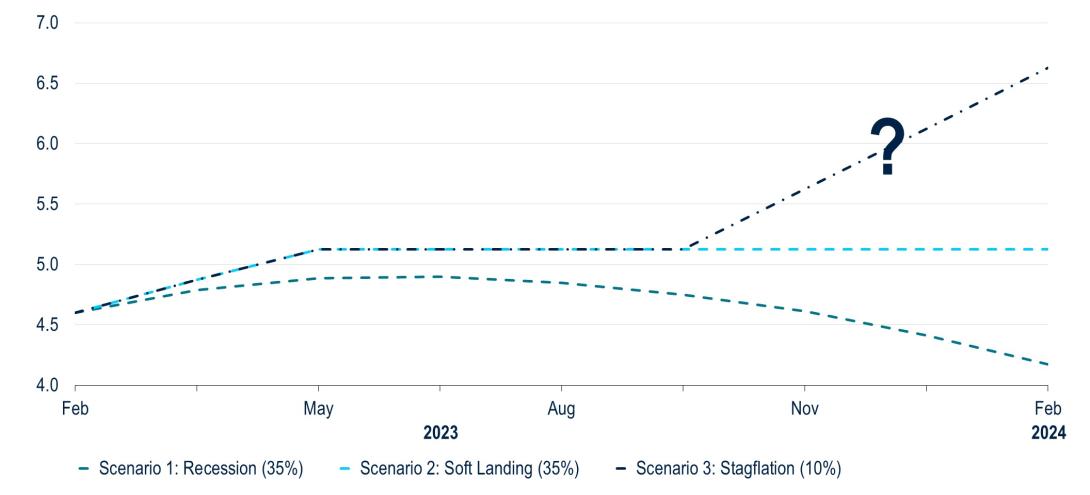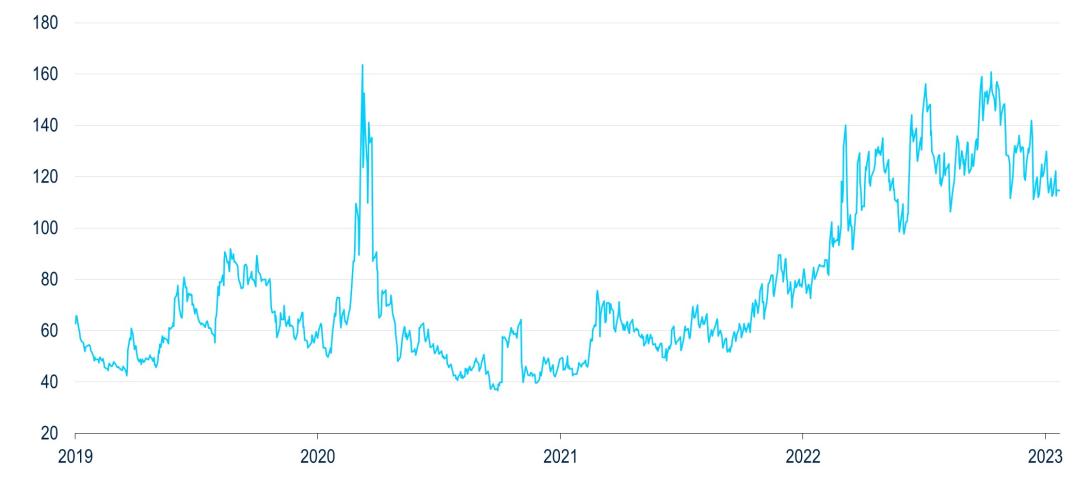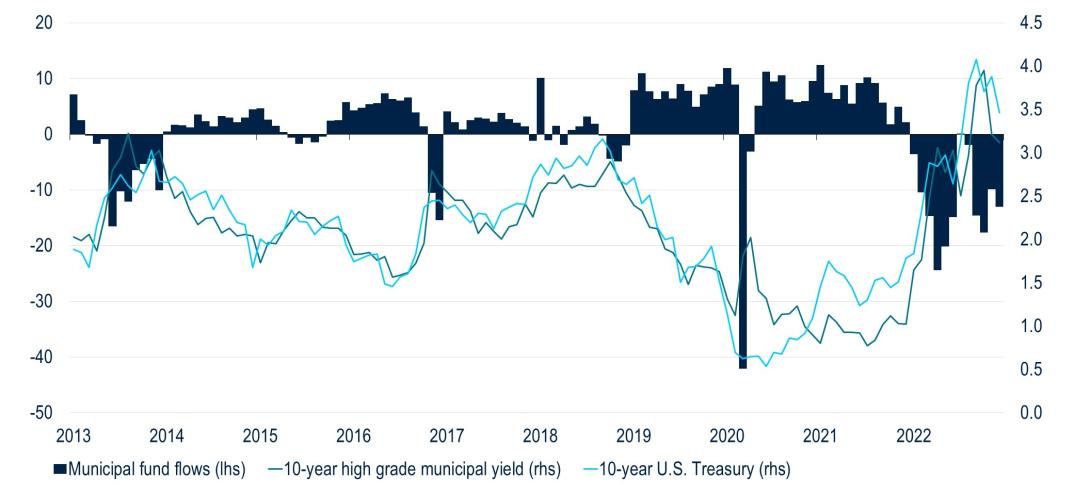Beyond the Muni Bond Bounce

The municipal bond market experienced blistering losses last year as Treasury yields repriced amid the surge in inflation. However, the first weeks of 2023 brought a far different story, and a more favorable backdrop has taken hold. Interest rates and credit spreads have declined sharply as investors begin to price in an increased probability that the economy could thread the needle with decelerating inflation and continued—albeit more gradual—economic growth. Through the first four weeks of the year, investment grade and high yield municipal bonds are already up 2.9% and 4.6%, respectively. Additionally, municipal bonds have appreciated faster than Treasuries, driving the municipal-to-Treasury yield ratio to 12-month tights.1 This rapid change in fortune begs the question: Is this market rally sustainable or just a bear market bounce?
To help answer this question, we examine three possible policy scenarios and assign a probability to each outcome in Figure 1: One in which the Fed pivots, one in which it holds rates relatively steady, and one in which it is forced to continue hiking rates.
Figure 1: PGIM Fixed Income’s Three Possible Market Scenarios (Fed funds rate, %)

Source: PGIM Fixed Income as of January 24, 2023.
The Market’s Current Path
Under the first scenario, the Fed follows the course that markets have charted. Looking at the Fed funds futures curve, short-term rates are expected to reach a peak relatively soon. Subsequently, the market is expecting the Fed to pivot by cutting rates later in the year. This course of action would likely follow a string of sequentially lower inflation prints coupled with a slowing economy—opening the door for a steeper yield curve, led by lower front-end rates. Furthermore, confidence would continue to build that policy is on a more predictable path as 75 bp and 50 bp rate hikes are likely in the past. As a result, after cresting at the highest levels since 2009, implied rate volatility finally appears to be rolling over (Figure 2).
Figure 2: Rate Volatility Declines as Markets Price in a More Defined Path for Rate Hikes

Source: PGIM Fixed Income, BofAML. MOVE Index as of January 23, 2023.
As the Fed pivots, municipal rates would likely follow taxable rates lower given their strong correlation of 0.69 over the past 10 years. In addition to the muni/Treasury correlation, Figure 3 shows the strong, inverse relationship between Treasury rates and flows into/out of the municipal market. Therefore, open-end mutual funds would likely attract capital as investors grow increasingly confident that rates will drift lower. In contrast to the outflows of 2022 that led to rising yields, these inflows would likely lead to lower yields and positive returns in the municipal market.
Figure 3: Lower Rates Drive Muni Inflows (LHS: in $ billions; RHS: %)

Source: PGIM Fixed Income, Barclays, ICI as of December 31, 2022.
As the Fed pivots, municipal rates would likely follow taxable rates lower given their strong correlation of 0.69 over the past 10 years. In addition to the muni/Treasury correlation, Figure 3 shows the strong, inverse relationship between Treasury rates and flows into/out of the municipal market. Therefore, open-end mutual funds would likely attract capital as investors grow increasingly confident that rates will drift lower. In contrast to the outflows of 2022 that led to rising yields, these inflows would likely lead to lower yields and positive returns in the municipal market.
The Path that Pauses
Under the second scenario, the Fed reaches peak rates relatively soon, but decides to pause near a peak target of about 4.75-5.00% as it observes whether inflation will recede to its 2% target. Short-term rates would likely remain relatively unchanged and the yield curve could remain near its current, inverted levels or invert even further.
While other spread products may falter due to recession fears and tighter financial conditions, municipal bonds may benefit from a flight-to-quality as investors seek shelter in an asset class with lower default rates and lower probability of downgrades in credit ratings (Figure 4). In addition to the flight-to-safety, munis’ transition probabilities are lower due to their limited exposure to event risk, such as debt financed M&A or stock buybacks.
Figure 4: Municipal ratings transition less frequently than global corporates
 Source: Moody’s Investors Service as of April 21, 2022. Average one-year rating transition rates, 1970-2021, municipal vs. global corporate issuers.
Source: Moody’s Investors Service as of April 21, 2022. Average one-year rating transition rates, 1970-2021, municipal vs. global corporate issuers.
In addition, rate volatility could continue to diminish as investors no longer fear the threat of even higher rates and muni investors could continue collecting the currently high tax-advantaged yields. With a yield-to-worst of approximately 3.10%, the muni index currently provides a taxable-equivalent yield of more than 5.0%, with a further benefit to residents of high tax states. This, too, could lead to additional municipal bond mutual fund inflows and spread tightening.
Stagflation Scenario Waning, but not Gone
Finally, under a third scenario, inflation reaccelerates and the Fed is forced to change directions. Instead of a downshift, the Fed continues rate hikes, possibly for a longer period of time than expected. This would drive rates higher than current levels, potentially across the entire yield curve. Higher inflation combined with a slower economy leads to a stagflationary environment in which spreads and rates move simultaneously higher. Stagflation fears were pervasive in 2022, leading to the sharp losses mentioned above. This “risk” scenario could push performance into the red as higher rates reduce the appeal of fixed income investments. Municipal bond spreads have already tightened versus Treasuries, with the 10-year municipal/Treasury ratio now sitting at an historically rich 63%. With municipal bond valuations somewhat stretched, muni yields would likely follow Treasury rates higher under this scenario.
While each of the three scenarios are possible, we believe the probability of positive outcomes for the municipal market is growing at the expense of the third, or “risk,” scenario. As the market’s reaction to this week’s FOMC meeting demonstrated, the probability of a Fed pause or pivot appears to be growing. Our scenarios currently assign a low probability to the stagflation outcome (10%) and a high probability to either recession (35%) or a soft landing (35%). While there are additional permutations (e.g. resilient or accelerating growth) that may result in positive or negative outcomes for municipal bonds, we are becoming increasingly optimistic over the potential for sustained, positive market performance over the remainder of 2023.
Read More from PGIM Fixed Income
1 The Municipal/Treasury Ratio compares the current yield of municipal bonds to U.S. Treasuries to determine how attractive they are by comparison.
Source(s) of data (unless otherwise noted): PGIM Fixed Income, as 2/3/2023.
For Professional Investors only. Past performance is not a guarantee or a reliable indicator of future results and an investment could lose value. All investments involve risk, including the possible loss of capital.
PGIM Fixed Income operates primarily through PGIM, Inc., a registered investment adviser under the U.S. Investment Advisers Act of 1940, as amended, and a Prudential Financial, Inc. (“PFI”) company. Registration as a registered investment adviser does not imply a certain level or skill or training. PGIM Fixed Income is headquartered in Newark, New Jersey and also includes the following businesses globally: (i) the public fixed income unit within PGIM Limited, located in London; (ii) PGIM Netherlands B.V., located in Amsterdam; (iii) PGIM Japan Co., Ltd. (“PGIM Japan”), located in Tokyo; (iv) the public fixed income unit within PGIM (Hong Kong) Ltd. located in Hong Kong; and (v) the public fixed income unit within PGIM (Singapore) Pte. Ltd., located in Singapore (“PGIM Singapore”). PFI of the United States is not affiliated in any manner with Prudential plc, incorporated in the United Kingdom or with Prudential Assurance Company, a subsidiary of M&G plc, incorporated in the United Kingdom. Prudential, PGIM, their respective logos, and the Rock symbol are service marks of PFI and its related entities, registered in many jurisdictions worldwide.
These materials are for informational or educational purposes only. The information is not intended as investment advice and is not a recommendation about managing or investing assets. In providing these materials, PGIM is not acting as your fiduciary. PGIM Fixed Income as a general matter provides services to qualified institutions, financial intermediaries and institutional investors. Investors seeking information regarding their particular investment needs should contact their own financial professional.
These materials represent the views and opinions of the author(s) regarding the economic conditions, asset classes, securities, issuers or financial instruments referenced herein. Distribution of this information to any person other than the person to whom it was originally delivered and to such person’s advisers is unauthorized, and any reproduction of these materials, in whole or in part, or the divulgence of any of the contents hereof, without prior consent of PGIM Fixed Income is prohibited. Certain information contained herein has been obtained from sources that PGIM Fixed Income believes to be reliable as of the date presented; however, PGIM Fixed Income cannot guarantee the accuracy of such information, assure its completeness, or warrant such information will not be changed. The information contained herein is current as of the date of issuance (or such earlier date as referenced herein) and is subject to change without notice. PGIM Fixed Income has no obligation to update any or all of such information; nor do we make any express or implied warranties or representations as to the completeness or accuracy.
Any forecasts, estimates and certain information contained herein are based upon proprietary research and should not be interpreted as investment advice, as an offer or solicitation, nor as the purchase or sale of any financial instrument. Forecasts and estimates have certain inherent limitations, and unlike an actual performance record, do not reflect actual trading, liquidity constraints, fee. These materials are not intended as an offer or solicitation with respect to the purchase or sale of any security or other financial instrument or any investment management services and should not be used as the basis for any investment decision. PGIM Fixed Income and its affiliates may make investment decisions that are inconsistent with the recommendations or views expressed herein, including for proprietary accounts of PGIM Fixed Income or its affiliates.
Investing in the bond market is subject to risks, including market, interest rate, issuer, credit, inflation risk, and liquidity risk. The value of most bonds and bond strategies are impacted by changes in interest rates. Bonds and bond strategies with longer durations tend to be more sensitive and volatile than those with shorter durations; bond prices generally fall as interest rates rise, and low interest rate environments increase this risk. Reductions in bond counterparty capacity may contribute to decreased market liquidity and increased price volatility. Bond investments may be worth more or less than the original cost when redeemed. Mortgage- and asset-backed securities may be sensitive to changes in interest rates, subject to early repayment risk, and while generally supported by a government, government agency or private guarantor, there is no assurance that the guarantor will meet its obligations. High yield, lower-rated securities involve greater risk than higher-rated securities; portfolios that invest in them may be subject to greater levels of credit and liquidity risk than portfolios that do not. Investing in foreign-denominated and/or -domiciled securities may involve heightened risk due to currency fluctuations, and economic and political risks, which may be enhanced in emerging markets. Currency rates may fluctuate significantly over short periods of time and may reduce the returns of a portfolio. Commodities contain heightened risk, including market, political, regulatory and natural conditions, and may not be suitable for all investors. Diversification does not ensure against loss.
In the United Kingdom, information is issued by PGIM Limited with registered office: Grand Buildings, 1-3 Strand, Trafalgar Square, London, WC2N 5HR. PGIM Limited is authorised and regulated by the Financial Conduct Authority (“FCA”) of the United Kingdom (Firm Reference Number 193418). In the European Economic Area (“EEA”), information is issued by PGIM Netherlands B.V., an entity authorised by the Autoriteit Financiële Markten (“AFM”) in the Netherlands and operating on the basis of a European passport. In certain EEA countries, information is, where permitted, presented by PGIM Limited in reliance of provisions, exemptions or licenses available to PGIM Limited under temporary permission arrangements following the exit of the United Kingdom from the European Union. These materials are issued by PGIM Limited and/or PGIM Netherlands B.V. to persons who are professional clients as defined under the rules of the FCA and/or to persons who are professional clients as defined in the relevant local implementation of Directive 2014/65/EU (MiFID II). In certain countries in Asia-Pacific, information is presented by PGIM (Singapore) Pte. Ltd., a Singapore investment manager registered with and licensed by the Monetary Authority of Singapore. In Japan, information is presented by PGIM Japan Co. Ltd., registered investment adviser with the Japanese Financial Services Agency. In South Korea, information is presented by PGIM, Inc., which is licensed to provide discretionary investment management services directly to South Korean investors. In Hong Kong, information is provided by PGIM (Hong Kong) Limited, a regulated entity with the Securities & Futures Commission in Hong Kong to professional investors as defined in Section 1 of Part 1 of Schedule 1 (paragraph (a) to (i) of the Securities and Futures Ordinance (Cap.571). In Australia, this information is presented by PGIM (Australia) Pty Ltd (“PGIM Australia”) for the general information of its “wholesale” customers (as defined in the Corporations Act 2001). PGIM Australia is a representative of PGIM Limited, which is exempt from the requirement to hold an Australian Financial Services License under the Australian Corporations Act 2001 in respect of financial services. PGIM Limited is exempt by virtue of its regulation by the FCA (Reg: 193418) under the laws of the United Kingdom and the application of ASIC Class Order 03/1099. The laws of the United Kingdom differ from Australian laws. In Canada, pursuant to the international adviser registration exemption in National Instrument 31-103, PGIM, Inc. is informing you that: (1) PGIM, Inc. is not registered in Canada and is advising you in reliance upon an exemption from the adviser registration requirement under National Instrument 31-103; (2) PGIM, Inc.’s jurisdiction of residence is New Jersey, U.S.A.; (3) there may be difficulty enforcing legal rights against PGIM, Inc. because it is resident outside of Canada and all or substantially all of its assets may be situated outside of Canada; and (4) the name and address of the agent for service of process of PGIM, Inc. in the applicable Provinces of Canada are as follows: in Québec: Borden Ladner Gervais LLP, 1000 de La Gauchetière Street West, Suite 900 Montréal, QC H3B 5H4; in British Columbia: Borden Ladner Gervais LLP, 1200 Waterfront Centre, 200 Burrard Street, Vancouver, BC V7X 1T2; in Ontario: Borden Ladner Gervais LLP, 22 Adelaide Street West, Suite 3400, Toronto, ON M5H 4E3; in Nova Scotia: Cox & Palmer, Q.C., 1100 Purdy’s Wharf Tower One, 1959 Upper Water Street, P.O. Box 2380 - Stn Central RPO, Halifax, NS B3J 3E5; in Alberta: Borden Ladner Gervais LLP, 530 Third Avenue S.W., Calgary, AB T2P R3.
© 2023 PFI and its related entities.
2023-1097
Sign Up Now for Full Access to Articles and Podcasts!
Unlock full access to our vast content library by registering as an institutional investor .
Create an accountAlready have an account ? Sign in
